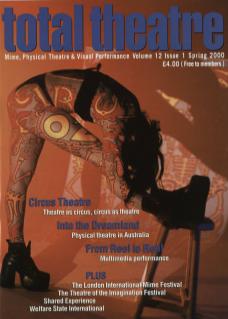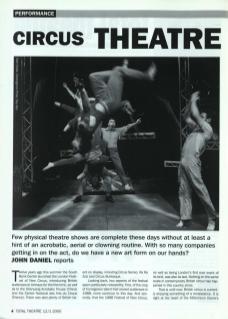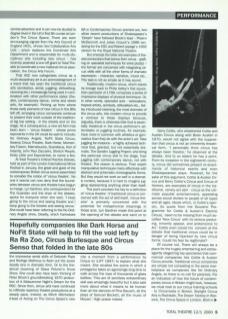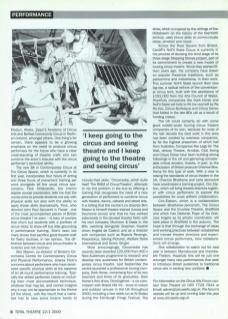Twelve years ago this summer the South Bank Centre launched the London Festival of New Circus, introducing British audiences to Archaos for the first time, as well as to the Shenyang Acrobatic Troupe (China) and the Centre National des Arts du Cirque (France). There was also plenty of British talent on display, including Circus Senso, Ra-Ra Zoo and Circus Burlesque.
Looking back, two aspects of the festival seem particularly noteworthy. First, of the crop of homegrown talent that wowed audiences in 1988, none continue to this day. And secondly, that the 1988 Festival of New Circus, as well as being London's first ever event of its kind, was also its last. Nothing on the same scale in contemporary British circus has happened in this country since.
That is until now. British circus is currently enjoying something of a renaissance. It is right at the heart of the Millennium Dome's central attraction and it can now be studied to degree level in the UK's first BA course at London's Circus Space. There are even encouraging signals from the Arts Council of England (ACE), whose new Collaborative Arts Unit – which replaces the combined Arts Department and is responsible for multi-disciplinary arts including new circus – has recently awarded a one-off grant to Total Theatre to coordinate a new national circus association, the Circus Arts Forum.
That ACE now categorises circus as a multi-disciplinary art is an acknowledgement of a trend that has seen the traditional circus arts (acrobatics, aerial, juggling, stilt walking, clowning, etc) increasingly being used in combination with other performance styles (theatre, contemporary dance, mime and street arts, for example). Picking up from where those early pioneers of new circus in the 80s left off, emerging circus companies continue to present their work outside of the traditional big top setting – in the streets and on the stage. As a consequence, a new artform has been born – 'circus theatre' – whose prime exponents in the UK could be said to include: No Ordinary Angels, NoFit State Circus, Swamp Circus Theatre, Dark Horse, Momentary Fusion, Mamaloucos, Scarabeus, Heir of Insanity, John-Paul Zaccarini, Stretch People, Kirsty Little and Exponential, to name a few.
At Total Theatre's Critical Practice Debate, held as part of the London International Mime Festival in January, the great and good of the contemporary British circus scene assembled to consider the notion of 'circus theatre'. No one it seems can now deny that the boundaries between circus and theatre have begun to merge. Lyn Gardner, arts correspondent for The Guardian and the chair of the debate, spoke for everyone when she said, 'I keep going to the circus and seeing theatre and I keep going to the theatre and seeing circus.’ She could have been referring to the No Ordinary Angels show, Deadly, which harnesses the impressive aerial skills of Deborah Pope and Rodrigo Matheus to flesh out the seven deadly sins in dramatic form. Or to the theatrical clowning of Slava Polunin's Snow Show. She could also have been thinking of Peter Brook's groundbreaking 1970 production of A Midsummer Night's Dream for the RSC. Since then, circus arts have continued to infiltrate repertory theatre productions at a steady pace. Indeed, as Mitch Mitchelson (Head of Acting on the Circus Space's new BA in Contemporary Circus) pointed out, two other recent productions of Shakespeare's Dream have followed Brook's lead – Phelim McDermott and Julian Crouch's 1996 rendering for the ESC and Robert Lepage's 1992 version for the Royal National Theatre.
But whereas the latter are examples of theatre productions that borrow from circus – grafting on specialist techniques for extra pizzazz – the former are concerned with integrating circus skills with all the other forms of dramatic expression – character, narrative, mood etc. This task is not as simple as it may sound.
Traditionally, modern circus, which traces its lineage back to Philip Astley's first equestrian spectacle of 1768, comprises a series of impressive displays of physical technique. Or, in other words, specialist acts – wire walkers, trapeze artists, acrobats, stilt walkers, etc. Astley introduced clowning, the most dramatic of the circus arts, into modern circus to provide a contrast to these displays because, arguably, there is otherwise little that is essentially theatrical in the circus performer's art. Acrobatic or juggling routines, for example, have more in common with athletics or gymnastics than they do with the actor's art. Take juggling for instance – a highly achieved technical feat, granted, but not essentially dramatic. The Gandini Juggling Project, who bring this particular circus skill to the stage, fuse juggling with contemporary dance, not with theatre. The reason is obvious. Their expert manipulative techniques marry effectively with abstract and schematic choreographic forms. But they would not work so well in a dramatic context, because it is hard to imagine juggling representing anything other than itself.
This point provides the key to a definition of 'circus theatre'. If traditional circus is concerned with the act of skill itself, 'circus theatre' is primarily concerned with the potential for metaphorical meanings in those acts. Lyn Gardner made this point at the opening of the debate and went on to cite a moment from a performance by Cirque Ici (LIFT 1997) to explain what she meant. She recalled the scene in which a protagonist takes an agonisingly long time to walk across the tops of thousands of glass bottles: ‘This act of pointless extraordinary skill was amazingly beautiful but it also said more about what it means to be human than all the dancers of Pina Bausch, all the plays of Samuel Beckett, all the music of Mozart.’ High praise indeed.
“I keep going to the circus and seeing theatre and I keep going to the theatre and seeing circus” – Lyn Gardner
Gerry Cottle, who established Cottle and Austen Circus along with Brian Austen in 1970, would not agree with the supposition that circus is not an inherently theatrical form. 'I personally think circus has always been theatre,' he observed at the debate. And to an extent he has a point. From its inception in the eighteenth century, circus did sometimes present re-enactments of historical events and even Shakespearean plays. However, for the sake of this argument, Cottle & Austen Circus and Gerry Cottle's Circus and Circus of Horrors, are examples of circus in the traditional, variety-act vein – circus as the ultimate populist entertainment, appealing across social divides to people of all types and all ages. Ideals which, in Cottie's opinion (to quote from the Souvenir Programme for Cottle & Austen's Electric Circus) 'seem to be missing from much so-called “New Circus” with its serious posturing, minority appeal, and pretensions to Art’. Cottle even voiced his concern at the debate that traditional circus could be in danger of being hijacked by new circus forms. Could his fear be legitimate?
Of course not. There will always be a place for the hugely entertaining and extravagantly staged big top spectacles that commercial companies like Cottle & Austen Circus provide. Traditional circus companies are simply not competing in the same marketplace as companies like No Ordinary Angels, so there is no call for paranoia. For an indication of how the future of contemporary Circus in Britain might look, however, we must look to our circus training schools – to Circomedia in Bristol, Skylight Circus Arts in Rochdale, The Dream Factory in Warwick, The Circus Space in London, Broli in Mostyn, Wales, Zippo's Academy of Circus Arts and Belfast Community Circus in Northern Ireland, amongst others. One thing's for certain, there appears to be a growing emphasis on the need to produce circus performers for the future who have a clear understanding of theatre craft; who can combine the actor's impulse with the circus performer's technical ability.
The new BA in Contemporary Circus at the Circus Space, which is currently in its first year, incorporates four hours of acting and three hours of movement training per week alongside all the usual circus specialisms. Flick Ferdinando, the interim degree course coordinator, tells me that the course aims to provide students not only with physical skills but also with the ability to apply those skills dramatically. Flick, who directed John-Paul Zaccarini in Throat – one of the most accomplished pieces of British circus theatre I've seen – is wary of courses that churn out students with a portfolio of circus tricks to show-off but little grounding in performance training. She's seen too many shows that sacrifice good theatre craft for flashy routines. In her opinion, ‘the difference between circus and circus theatre is routines and not routines’.
Bim Mason, co-director of Bristol's Circomedia Centre for Contemporary Circus and Physical Performance, shares Flick's concerns about performers who have developed specific physical skills at the expense of an all-round performance training. 'Typically the skilled performer insists on including their most accomplished technique, whatever that may be, and cannot imagine why it may not be appropriate to the theme [of the show], with the result that a narrative has to take some bizarre twists to include their skills.' Circomedia, which dubs itself 'The RADA of Circus/Theatre', attempts to nip this problem in the bud by offering a training that recognises the need of a new generation of performers to combine circus with theatre, dance, cabaret and street arts. It is telling that the centre's co-director Bim Mason is himself theatre-trained (Lecoq and Desmond Jones) and that he has worked extensively in the devised theatre field; with his own company Mummer & Dada in the 80s (working alongside Brazilian theatre clown Angela de Castro) and as a director with companies such as Rejects Revenge, Peepolykus, Talking Pictures, Welfare State International, and Green Ginger.
Most encouragingly, Circomedia has recently been awarded £20,000 from ACE's New Audiences programme to research and develop new audiences for British contemporary circus theatre. Last September the centre launched a professional touring company, Dark Horse, comprising four of its own teachers and three of its graduates. Dark Horse's first show, DiveUrgence – a co-commission with Bristol Old Vic – tours to indoor and outdoor venues in the UK throughout 2000, including a two-week run at St Bride’s during the Edinburgh Festival Fringe. The show, which is inspired by the writings of Eric Hobsbawm on the history of the twentieth century, uses circus skills to communicate ideas, emotion and mood.
Across the River Severn from Bristol, Cardiff's NoFit State Circus is currently in the process of devising the third stage of its three-stage Stepping Stones project, part of its commitment to create a new model of touring circus theatre. Since they started fifteen years ago, the company have drawn on popular theatrical traditions, such as pantomime and melodrama, in their work. This summer NoFit State launch their new big top, a radical rethink of the conventional circus tent, built with the assistance of £192,000 from the Arts Council of Wales. Hopefully companies like Dark Horse and NoFit State will help to fill the void left by Ra-Ra Zoo, Circus Burlesque and Circus Senso that folded in the late 80s (all as a result of funding crises).
The UK could certainly do with some good middle-scale touring circus theatre companies of its own, because for most of the last decade the best work in this area has been created by overseas companies, by far the highest proportion of which hail from Australia. Companies like Legs On The Wall, desoxy Theatre, Acrobat, Club Swing and Cirque Eloise have been building strong followings in the UK and garnering considerable critical acclaim, thanks, in part, to the enthusiasm of British producer Chenine Bhathena for this type of work. With a view to raising the standards of circus theatre in the UK, Chenine Bhathena and Leila Jancovich have coordinated a training project, Circ.Elation, which will bring theatre directors together with circus performers to explore the possibilities for cross-artform collaboration.
Circ.Elation, which is a collaboration between Bhathena-Jancovich, The Circus Space and the Crucible Theatre, Sheffield and which has Deborah Pope of No Ordinary Angels as its artistic coordinator, will take place in Sheffield in the autumn. The hope is that through the exchange of ideas and working practices between established and trainee theatre directors and experienced circus performers, new collaborations will emerge.
One collaboration to watch out for next year is between Mamaloucos and Improbable Theatre. Hopefully this will be just one amongst many new performances that seek to introduce British audiences to traditional circus arts in exciting new contexts.



